Evaluating Dialysis Treatments: Hemodialysis and Peritoneal Dialysis
VerifiedAdded on 2022/09/12
|9
|2372
|15
Report
AI Summary
This report provides a critical analysis comparing hemodialysis and peritoneal dialysis, focusing on the impact of each treatment method on patient quality of life (QOL). The report begins with background information on the definition of QOL and the challenges faced by patients with kidney complications, including the use of dialysis. It formulates a PICO question to guide the comparison between the two dialysis methods. The report then reviews both quantitative and qualitative studies to evaluate the Health-Related Quality of Living (HRQOL) in patients undergoing hemodialysis and peritoneal dialysis, comparing the methods, results, and findings. The studies reviewed include surveys, systematic reviews, and meta-analyses, which assess the impact of each dialysis method on physical and mental wellness, depression, and overall patient satisfaction. Ethical considerations in the studies are also discussed. The report concludes with a comparison of the two dialysis methods and their impact on patient well-being.
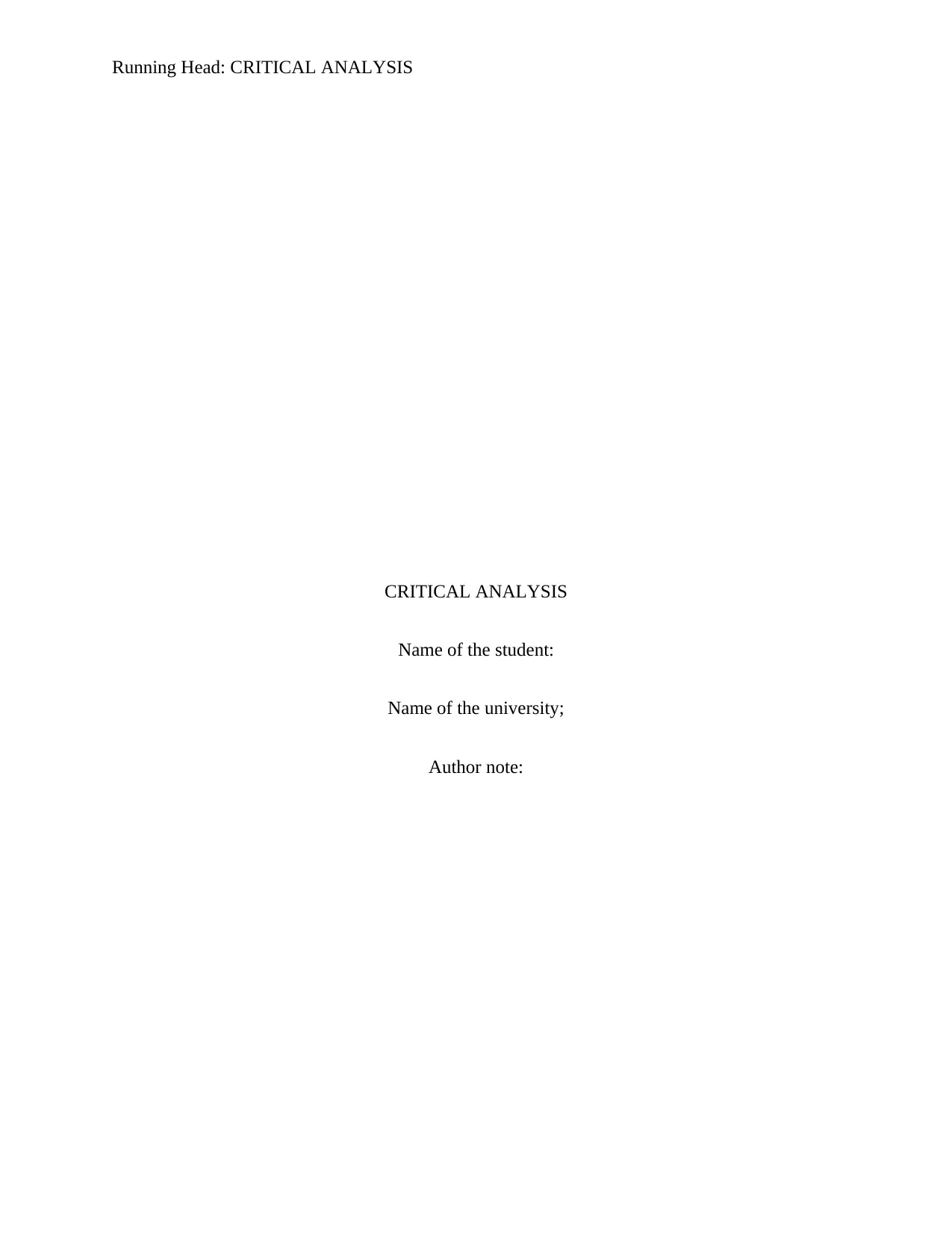
Running Head: CRITICAL ANALYSIS
CRITICAL ANALYSIS
Name of the student:
Name of the university;
Author note:
CRITICAL ANALYSIS
Name of the student:
Name of the university;
Author note:
Paraphrase This Document
Need a fresh take? Get an instant paraphrase of this document with our AI Paraphraser
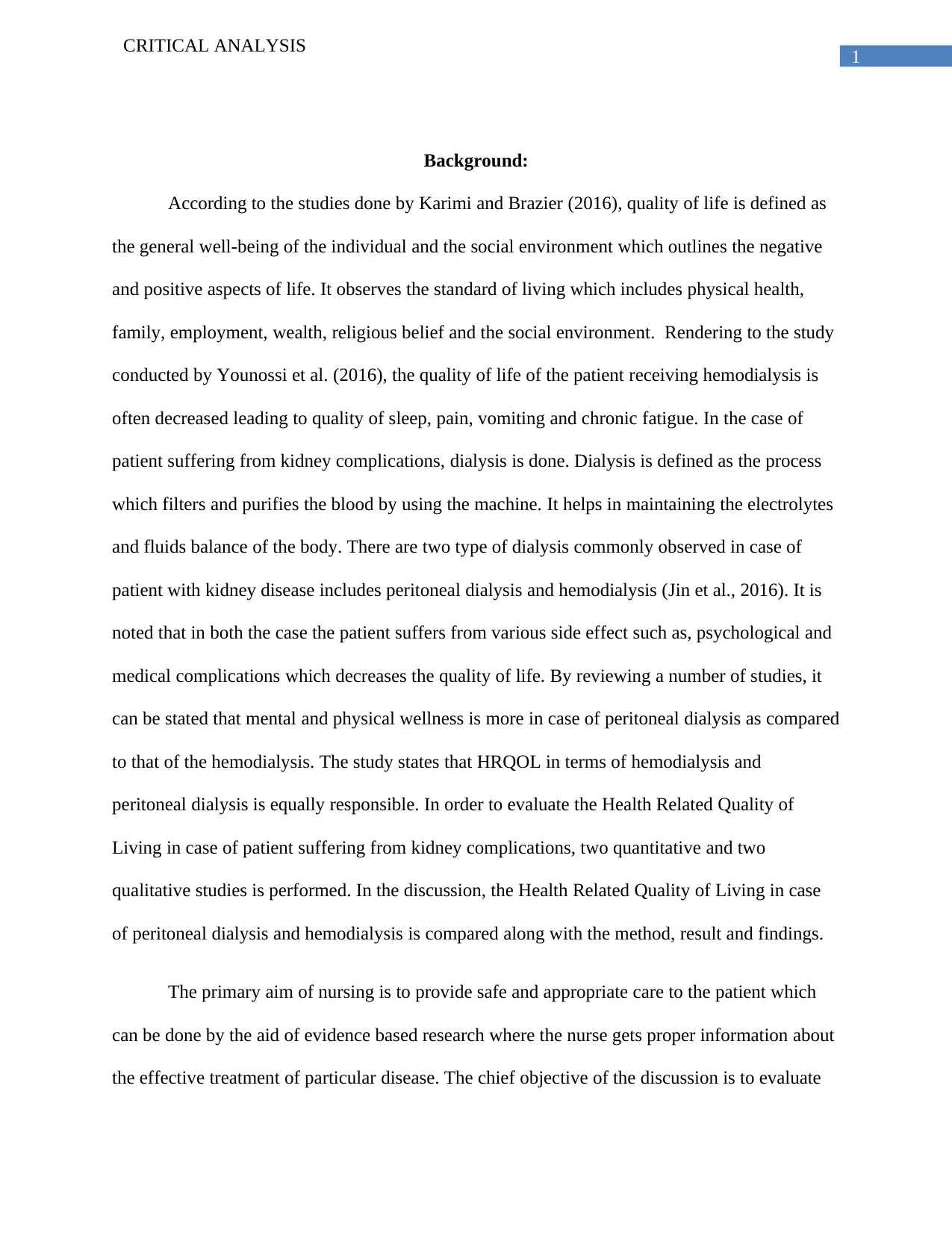
1
CRITICAL ANALYSIS
Background:
According to the studies done by Karimi and Brazier (2016), quality of life is defined as
the general well-being of the individual and the social environment which outlines the negative
and positive aspects of life. It observes the standard of living which includes physical health,
family, employment, wealth, religious belief and the social environment. Rendering to the study
conducted by Younossi et al. (2016), the quality of life of the patient receiving hemodialysis is
often decreased leading to quality of sleep, pain, vomiting and chronic fatigue. In the case of
patient suffering from kidney complications, dialysis is done. Dialysis is defined as the process
which filters and purifies the blood by using the machine. It helps in maintaining the electrolytes
and fluids balance of the body. There are two type of dialysis commonly observed in case of
patient with kidney disease includes peritoneal dialysis and hemodialysis (Jin et al., 2016). It is
noted that in both the case the patient suffers from various side effect such as, psychological and
medical complications which decreases the quality of life. By reviewing a number of studies, it
can be stated that mental and physical wellness is more in case of peritoneal dialysis as compared
to that of the hemodialysis. The study states that HRQOL in terms of hemodialysis and
peritoneal dialysis is equally responsible. In order to evaluate the Health Related Quality of
Living in case of patient suffering from kidney complications, two quantitative and two
qualitative studies is performed. In the discussion, the Health Related Quality of Living in case
of peritoneal dialysis and hemodialysis is compared along with the method, result and findings.
The primary aim of nursing is to provide safe and appropriate care to the patient which
can be done by the aid of evidence based research where the nurse gets proper information about
the effective treatment of particular disease. The chief objective of the discussion is to evaluate
CRITICAL ANALYSIS
Background:
According to the studies done by Karimi and Brazier (2016), quality of life is defined as
the general well-being of the individual and the social environment which outlines the negative
and positive aspects of life. It observes the standard of living which includes physical health,
family, employment, wealth, religious belief and the social environment. Rendering to the study
conducted by Younossi et al. (2016), the quality of life of the patient receiving hemodialysis is
often decreased leading to quality of sleep, pain, vomiting and chronic fatigue. In the case of
patient suffering from kidney complications, dialysis is done. Dialysis is defined as the process
which filters and purifies the blood by using the machine. It helps in maintaining the electrolytes
and fluids balance of the body. There are two type of dialysis commonly observed in case of
patient with kidney disease includes peritoneal dialysis and hemodialysis (Jin et al., 2016). It is
noted that in both the case the patient suffers from various side effect such as, psychological and
medical complications which decreases the quality of life. By reviewing a number of studies, it
can be stated that mental and physical wellness is more in case of peritoneal dialysis as compared
to that of the hemodialysis. The study states that HRQOL in terms of hemodialysis and
peritoneal dialysis is equally responsible. In order to evaluate the Health Related Quality of
Living in case of patient suffering from kidney complications, two quantitative and two
qualitative studies is performed. In the discussion, the Health Related Quality of Living in case
of peritoneal dialysis and hemodialysis is compared along with the method, result and findings.
The primary aim of nursing is to provide safe and appropriate care to the patient which
can be done by the aid of evidence based research where the nurse gets proper information about
the effective treatment of particular disease. The chief objective of the discussion is to evaluate
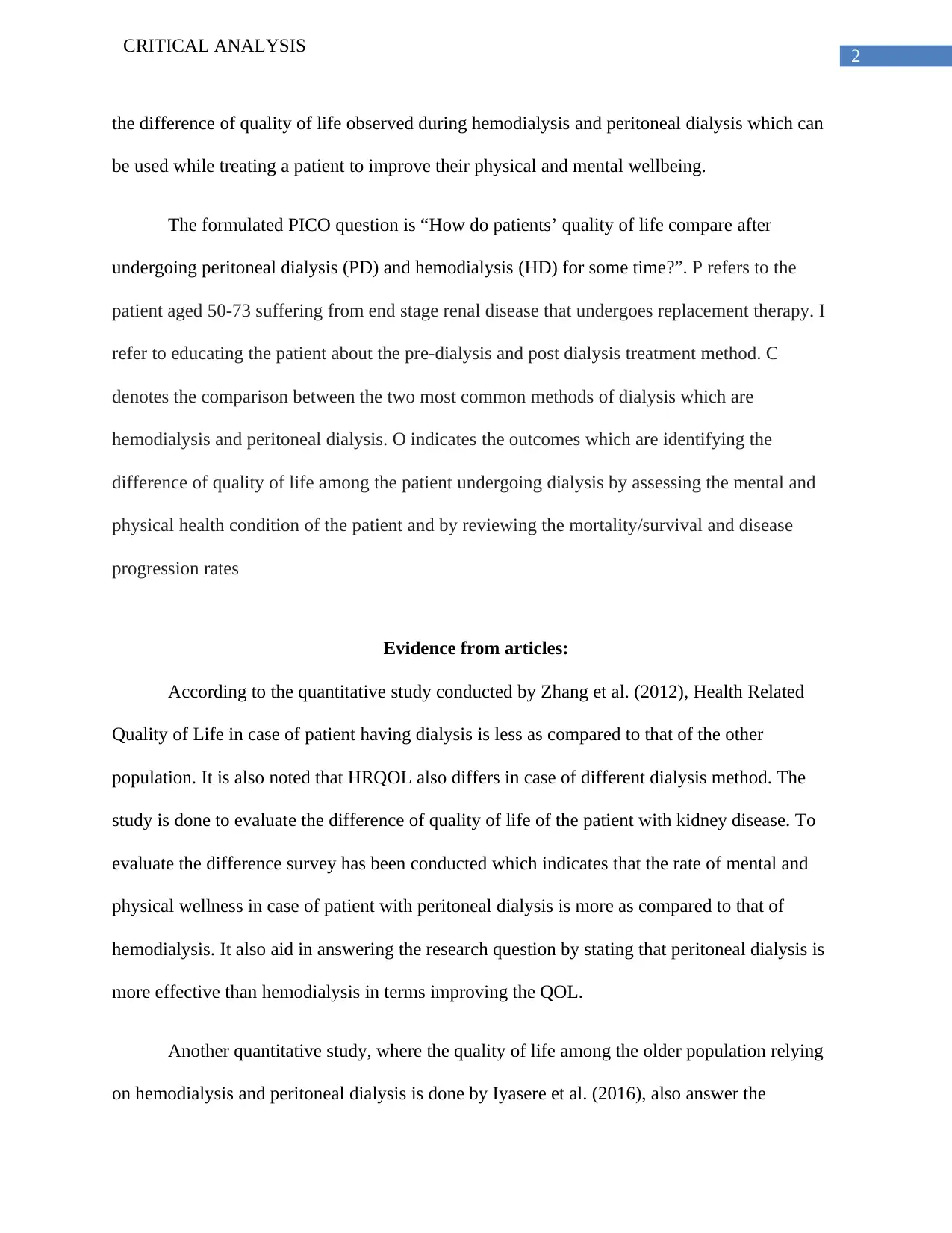
2
CRITICAL ANALYSIS
the difference of quality of life observed during hemodialysis and peritoneal dialysis which can
be used while treating a patient to improve their physical and mental wellbeing.
The formulated PICO question is “How do patients’ quality of life compare after
undergoing peritoneal dialysis (PD) and hemodialysis (HD) for some time?”. P refers to the
patient aged 50-73 suffering from end stage renal disease that undergoes replacement therapy. I
refer to educating the patient about the pre-dialysis and post dialysis treatment method. C
denotes the comparison between the two most common methods of dialysis which are
hemodialysis and peritoneal dialysis. O indicates the outcomes which are identifying the
difference of quality of life among the patient undergoing dialysis by assessing the mental and
physical health condition of the patient and by reviewing the mortality/survival and disease
progression rates
Evidence from articles:
According to the quantitative study conducted by Zhang et al. (2012), Health Related
Quality of Life in case of patient having dialysis is less as compared to that of the other
population. It is also noted that HRQOL also differs in case of different dialysis method. The
study is done to evaluate the difference of quality of life of the patient with kidney disease. To
evaluate the difference survey has been conducted which indicates that the rate of mental and
physical wellness in case of patient with peritoneal dialysis is more as compared to that of
hemodialysis. It also aid in answering the research question by stating that peritoneal dialysis is
more effective than hemodialysis in terms improving the QOL.
Another quantitative study, where the quality of life among the older population relying
on hemodialysis and peritoneal dialysis is done by Iyasere et al. (2016), also answer the
CRITICAL ANALYSIS
the difference of quality of life observed during hemodialysis and peritoneal dialysis which can
be used while treating a patient to improve their physical and mental wellbeing.
The formulated PICO question is “How do patients’ quality of life compare after
undergoing peritoneal dialysis (PD) and hemodialysis (HD) for some time?”. P refers to the
patient aged 50-73 suffering from end stage renal disease that undergoes replacement therapy. I
refer to educating the patient about the pre-dialysis and post dialysis treatment method. C
denotes the comparison between the two most common methods of dialysis which are
hemodialysis and peritoneal dialysis. O indicates the outcomes which are identifying the
difference of quality of life among the patient undergoing dialysis by assessing the mental and
physical health condition of the patient and by reviewing the mortality/survival and disease
progression rates
Evidence from articles:
According to the quantitative study conducted by Zhang et al. (2012), Health Related
Quality of Life in case of patient having dialysis is less as compared to that of the other
population. It is also noted that HRQOL also differs in case of different dialysis method. The
study is done to evaluate the difference of quality of life of the patient with kidney disease. To
evaluate the difference survey has been conducted which indicates that the rate of mental and
physical wellness in case of patient with peritoneal dialysis is more as compared to that of
hemodialysis. It also aid in answering the research question by stating that peritoneal dialysis is
more effective than hemodialysis in terms improving the QOL.
Another quantitative study, where the quality of life among the older population relying
on hemodialysis and peritoneal dialysis is done by Iyasere et al. (2016), also answer the
⊘ This is a preview!⊘
Do you want full access?
Subscribe today to unlock all pages.

Trusted by 1+ million students worldwide
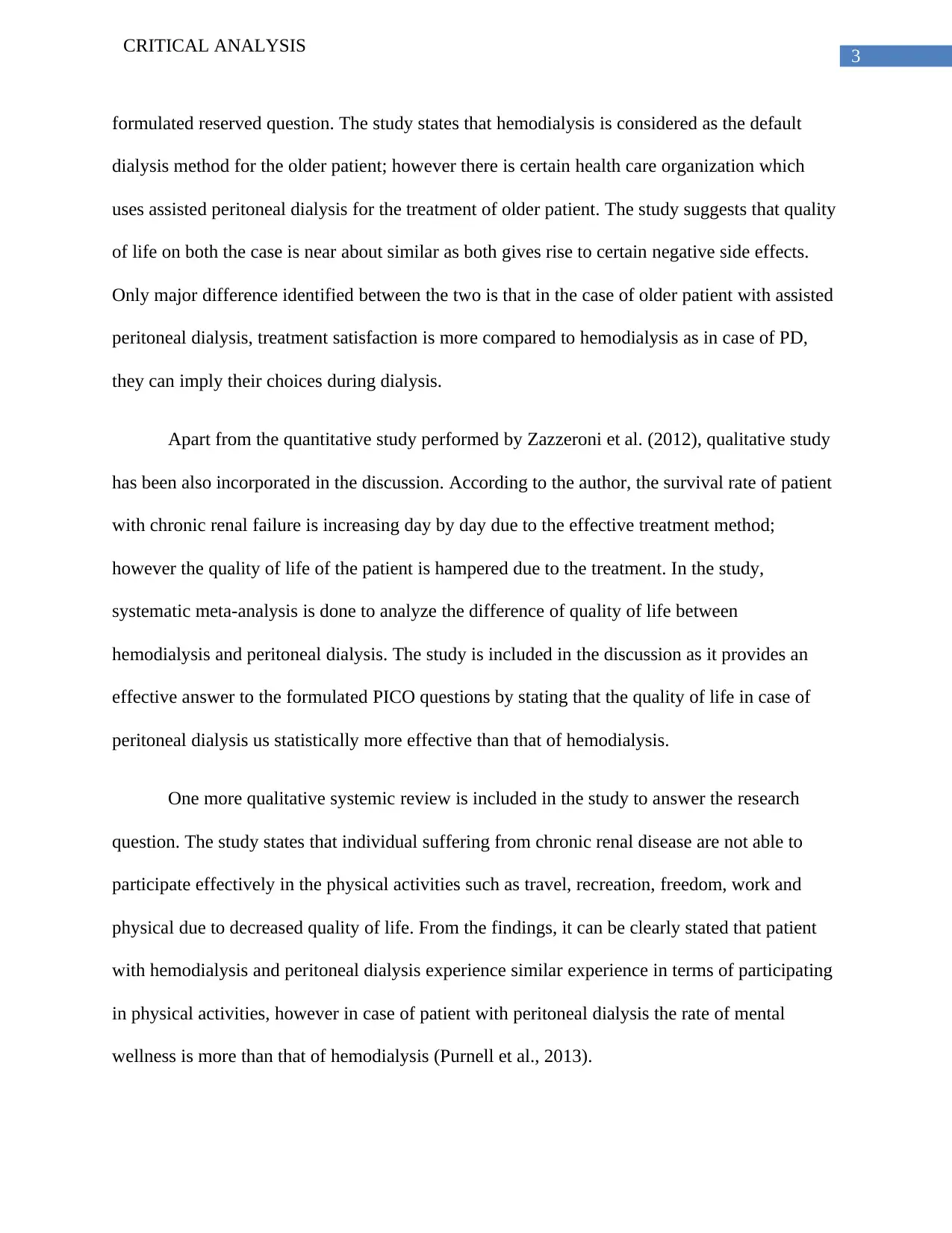
3
CRITICAL ANALYSIS
formulated reserved question. The study states that hemodialysis is considered as the default
dialysis method for the older patient; however there is certain health care organization which
uses assisted peritoneal dialysis for the treatment of older patient. The study suggests that quality
of life on both the case is near about similar as both gives rise to certain negative side effects.
Only major difference identified between the two is that in the case of older patient with assisted
peritoneal dialysis, treatment satisfaction is more compared to hemodialysis as in case of PD,
they can imply their choices during dialysis.
Apart from the quantitative study performed by Zazzeroni et al. (2012), qualitative study
has been also incorporated in the discussion. According to the author, the survival rate of patient
with chronic renal failure is increasing day by day due to the effective treatment method;
however the quality of life of the patient is hampered due to the treatment. In the study,
systematic meta-analysis is done to analyze the difference of quality of life between
hemodialysis and peritoneal dialysis. The study is included in the discussion as it provides an
effective answer to the formulated PICO questions by stating that the quality of life in case of
peritoneal dialysis us statistically more effective than that of hemodialysis.
One more qualitative systemic review is included in the study to answer the research
question. The study states that individual suffering from chronic renal disease are not able to
participate effectively in the physical activities such as travel, recreation, freedom, work and
physical due to decreased quality of life. From the findings, it can be clearly stated that patient
with hemodialysis and peritoneal dialysis experience similar experience in terms of participating
in physical activities, however in case of patient with peritoneal dialysis the rate of mental
wellness is more than that of hemodialysis (Purnell et al., 2013).
CRITICAL ANALYSIS
formulated reserved question. The study states that hemodialysis is considered as the default
dialysis method for the older patient; however there is certain health care organization which
uses assisted peritoneal dialysis for the treatment of older patient. The study suggests that quality
of life on both the case is near about similar as both gives rise to certain negative side effects.
Only major difference identified between the two is that in the case of older patient with assisted
peritoneal dialysis, treatment satisfaction is more compared to hemodialysis as in case of PD,
they can imply their choices during dialysis.
Apart from the quantitative study performed by Zazzeroni et al. (2012), qualitative study
has been also incorporated in the discussion. According to the author, the survival rate of patient
with chronic renal failure is increasing day by day due to the effective treatment method;
however the quality of life of the patient is hampered due to the treatment. In the study,
systematic meta-analysis is done to analyze the difference of quality of life between
hemodialysis and peritoneal dialysis. The study is included in the discussion as it provides an
effective answer to the formulated PICO questions by stating that the quality of life in case of
peritoneal dialysis us statistically more effective than that of hemodialysis.
One more qualitative systemic review is included in the study to answer the research
question. The study states that individual suffering from chronic renal disease are not able to
participate effectively in the physical activities such as travel, recreation, freedom, work and
physical due to decreased quality of life. From the findings, it can be clearly stated that patient
with hemodialysis and peritoneal dialysis experience similar experience in terms of participating
in physical activities, however in case of patient with peritoneal dialysis the rate of mental
wellness is more than that of hemodialysis (Purnell et al., 2013).
Paraphrase This Document
Need a fresh take? Get an instant paraphrase of this document with our AI Paraphraser
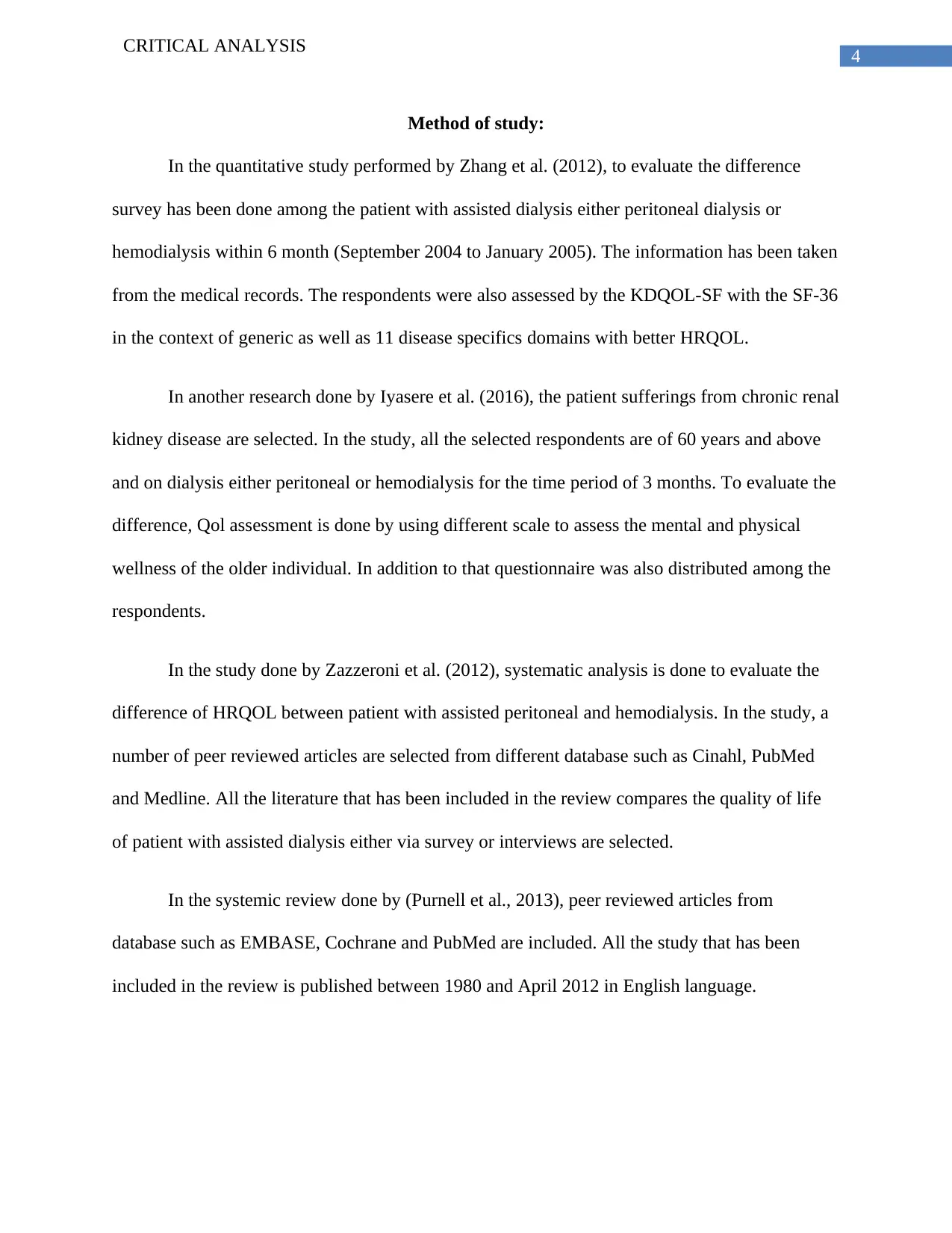
4
CRITICAL ANALYSIS
Method of study:
In the quantitative study performed by Zhang et al. (2012), to evaluate the difference
survey has been done among the patient with assisted dialysis either peritoneal dialysis or
hemodialysis within 6 month (September 2004 to January 2005). The information has been taken
from the medical records. The respondents were also assessed by the KDQOL-SF with the SF-36
in the context of generic as well as 11 disease specifics domains with better HRQOL.
In another research done by Iyasere et al. (2016), the patient sufferings from chronic renal
kidney disease are selected. In the study, all the selected respondents are of 60 years and above
and on dialysis either peritoneal or hemodialysis for the time period of 3 months. To evaluate the
difference, Qol assessment is done by using different scale to assess the mental and physical
wellness of the older individual. In addition to that questionnaire was also distributed among the
respondents.
In the study done by Zazzeroni et al. (2012), systematic analysis is done to evaluate the
difference of HRQOL between patient with assisted peritoneal and hemodialysis. In the study, a
number of peer reviewed articles are selected from different database such as Cinahl, PubMed
and Medline. All the literature that has been included in the review compares the quality of life
of patient with assisted dialysis either via survey or interviews are selected.
In the systemic review done by (Purnell et al., 2013), peer reviewed articles from
database such as EMBASE, Cochrane and PubMed are included. All the study that has been
included in the review is published between 1980 and April 2012 in English language.
CRITICAL ANALYSIS
Method of study:
In the quantitative study performed by Zhang et al. (2012), to evaluate the difference
survey has been done among the patient with assisted dialysis either peritoneal dialysis or
hemodialysis within 6 month (September 2004 to January 2005). The information has been taken
from the medical records. The respondents were also assessed by the KDQOL-SF with the SF-36
in the context of generic as well as 11 disease specifics domains with better HRQOL.
In another research done by Iyasere et al. (2016), the patient sufferings from chronic renal
kidney disease are selected. In the study, all the selected respondents are of 60 years and above
and on dialysis either peritoneal or hemodialysis for the time period of 3 months. To evaluate the
difference, Qol assessment is done by using different scale to assess the mental and physical
wellness of the older individual. In addition to that questionnaire was also distributed among the
respondents.
In the study done by Zazzeroni et al. (2012), systematic analysis is done to evaluate the
difference of HRQOL between patient with assisted peritoneal and hemodialysis. In the study, a
number of peer reviewed articles are selected from different database such as Cinahl, PubMed
and Medline. All the literature that has been included in the review compares the quality of life
of patient with assisted dialysis either via survey or interviews are selected.
In the systemic review done by (Purnell et al., 2013), peer reviewed articles from
database such as EMBASE, Cochrane and PubMed are included. All the study that has been
included in the review is published between 1980 and April 2012 in English language.
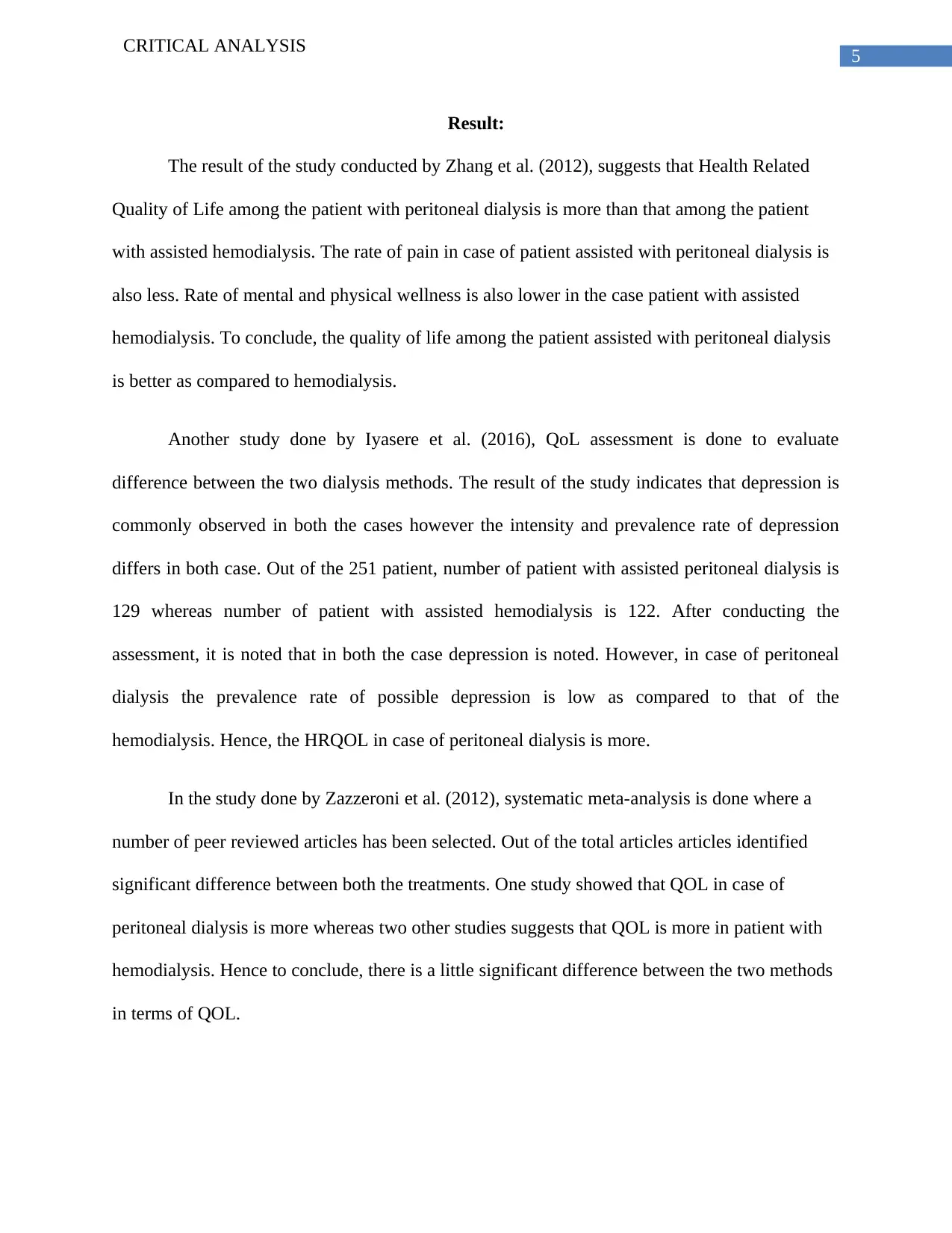
5
CRITICAL ANALYSIS
Result:
The result of the study conducted by Zhang et al. (2012), suggests that Health Related
Quality of Life among the patient with peritoneal dialysis is more than that among the patient
with assisted hemodialysis. The rate of pain in case of patient assisted with peritoneal dialysis is
also less. Rate of mental and physical wellness is also lower in the case patient with assisted
hemodialysis. To conclude, the quality of life among the patient assisted with peritoneal dialysis
is better as compared to hemodialysis.
Another study done by Iyasere et al. (2016), QoL assessment is done to evaluate
difference between the two dialysis methods. The result of the study indicates that depression is
commonly observed in both the cases however the intensity and prevalence rate of depression
differs in both case. Out of the 251 patient, number of patient with assisted peritoneal dialysis is
129 whereas number of patient with assisted hemodialysis is 122. After conducting the
assessment, it is noted that in both the case depression is noted. However, in case of peritoneal
dialysis the prevalence rate of possible depression is low as compared to that of the
hemodialysis. Hence, the HRQOL in case of peritoneal dialysis is more.
In the study done by Zazzeroni et al. (2012), systematic meta-analysis is done where a
number of peer reviewed articles has been selected. Out of the total articles articles identified
significant difference between both the treatments. One study showed that QOL in case of
peritoneal dialysis is more whereas two other studies suggests that QOL is more in patient with
hemodialysis. Hence to conclude, there is a little significant difference between the two methods
in terms of QOL.
CRITICAL ANALYSIS
Result:
The result of the study conducted by Zhang et al. (2012), suggests that Health Related
Quality of Life among the patient with peritoneal dialysis is more than that among the patient
with assisted hemodialysis. The rate of pain in case of patient assisted with peritoneal dialysis is
also less. Rate of mental and physical wellness is also lower in the case patient with assisted
hemodialysis. To conclude, the quality of life among the patient assisted with peritoneal dialysis
is better as compared to hemodialysis.
Another study done by Iyasere et al. (2016), QoL assessment is done to evaluate
difference between the two dialysis methods. The result of the study indicates that depression is
commonly observed in both the cases however the intensity and prevalence rate of depression
differs in both case. Out of the 251 patient, number of patient with assisted peritoneal dialysis is
129 whereas number of patient with assisted hemodialysis is 122. After conducting the
assessment, it is noted that in both the case depression is noted. However, in case of peritoneal
dialysis the prevalence rate of possible depression is low as compared to that of the
hemodialysis. Hence, the HRQOL in case of peritoneal dialysis is more.
In the study done by Zazzeroni et al. (2012), systematic meta-analysis is done where a
number of peer reviewed articles has been selected. Out of the total articles articles identified
significant difference between both the treatments. One study showed that QOL in case of
peritoneal dialysis is more whereas two other studies suggests that QOL is more in patient with
hemodialysis. Hence to conclude, there is a little significant difference between the two methods
in terms of QOL.
⊘ This is a preview!⊘
Do you want full access?
Subscribe today to unlock all pages.

Trusted by 1+ million students worldwide
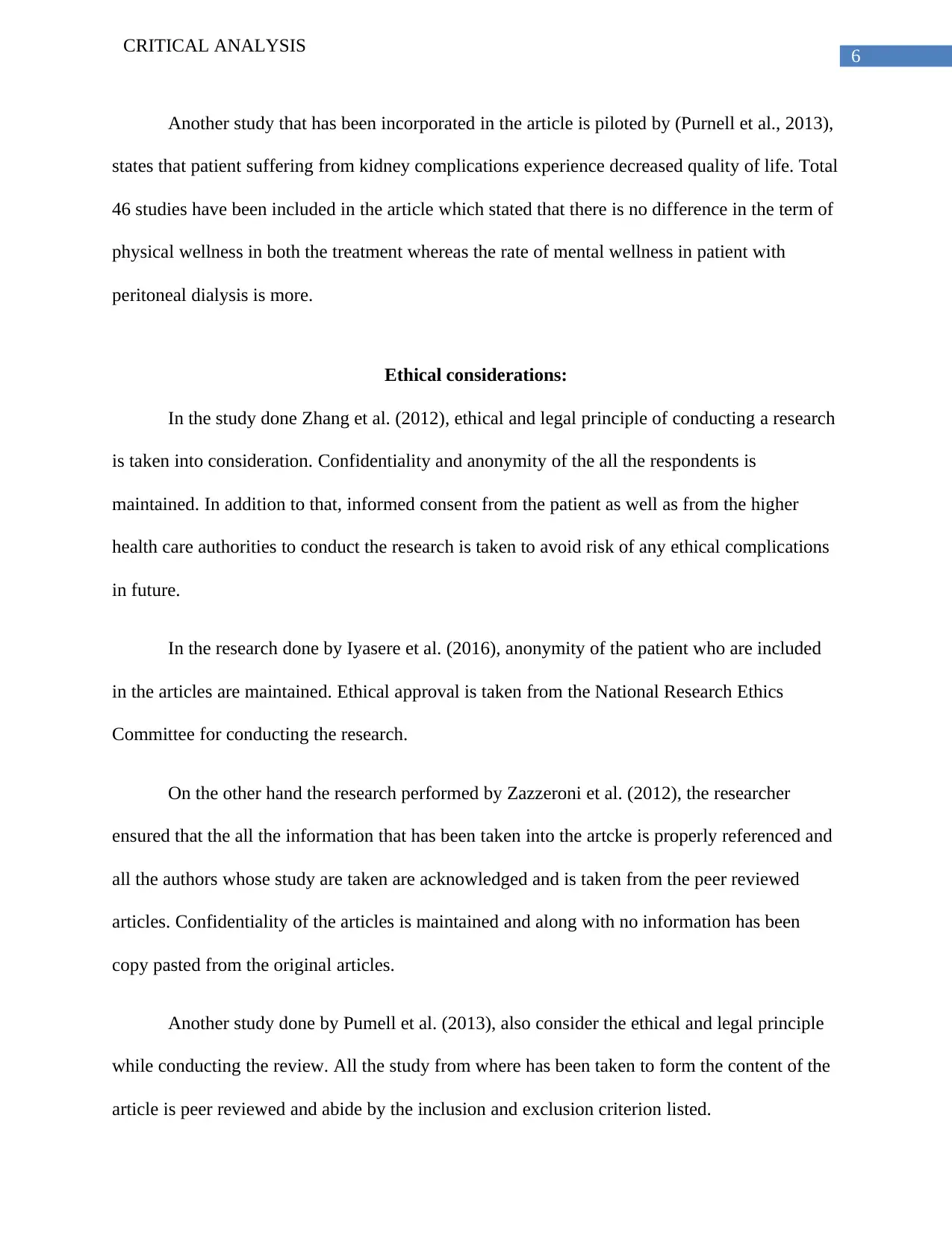
6
CRITICAL ANALYSIS
Another study that has been incorporated in the article is piloted by (Purnell et al., 2013),
states that patient suffering from kidney complications experience decreased quality of life. Total
46 studies have been included in the article which stated that there is no difference in the term of
physical wellness in both the treatment whereas the rate of mental wellness in patient with
peritoneal dialysis is more.
Ethical considerations:
In the study done Zhang et al. (2012), ethical and legal principle of conducting a research
is taken into consideration. Confidentiality and anonymity of the all the respondents is
maintained. In addition to that, informed consent from the patient as well as from the higher
health care authorities to conduct the research is taken to avoid risk of any ethical complications
in future.
In the research done by Iyasere et al. (2016), anonymity of the patient who are included
in the articles are maintained. Ethical approval is taken from the National Research Ethics
Committee for conducting the research.
On the other hand the research performed by Zazzeroni et al. (2012), the researcher
ensured that the all the information that has been taken into the artcke is properly referenced and
all the authors whose study are taken are acknowledged and is taken from the peer reviewed
articles. Confidentiality of the articles is maintained and along with no information has been
copy pasted from the original articles.
Another study done by Pumell et al. (2013), also consider the ethical and legal principle
while conducting the review. All the study from where has been taken to form the content of the
article is peer reviewed and abide by the inclusion and exclusion criterion listed.
CRITICAL ANALYSIS
Another study that has been incorporated in the article is piloted by (Purnell et al., 2013),
states that patient suffering from kidney complications experience decreased quality of life. Total
46 studies have been included in the article which stated that there is no difference in the term of
physical wellness in both the treatment whereas the rate of mental wellness in patient with
peritoneal dialysis is more.
Ethical considerations:
In the study done Zhang et al. (2012), ethical and legal principle of conducting a research
is taken into consideration. Confidentiality and anonymity of the all the respondents is
maintained. In addition to that, informed consent from the patient as well as from the higher
health care authorities to conduct the research is taken to avoid risk of any ethical complications
in future.
In the research done by Iyasere et al. (2016), anonymity of the patient who are included
in the articles are maintained. Ethical approval is taken from the National Research Ethics
Committee for conducting the research.
On the other hand the research performed by Zazzeroni et al. (2012), the researcher
ensured that the all the information that has been taken into the artcke is properly referenced and
all the authors whose study are taken are acknowledged and is taken from the peer reviewed
articles. Confidentiality of the articles is maintained and along with no information has been
copy pasted from the original articles.
Another study done by Pumell et al. (2013), also consider the ethical and legal principle
while conducting the review. All the study from where has been taken to form the content of the
article is peer reviewed and abide by the inclusion and exclusion criterion listed.
Paraphrase This Document
Need a fresh take? Get an instant paraphrase of this document with our AI Paraphraser
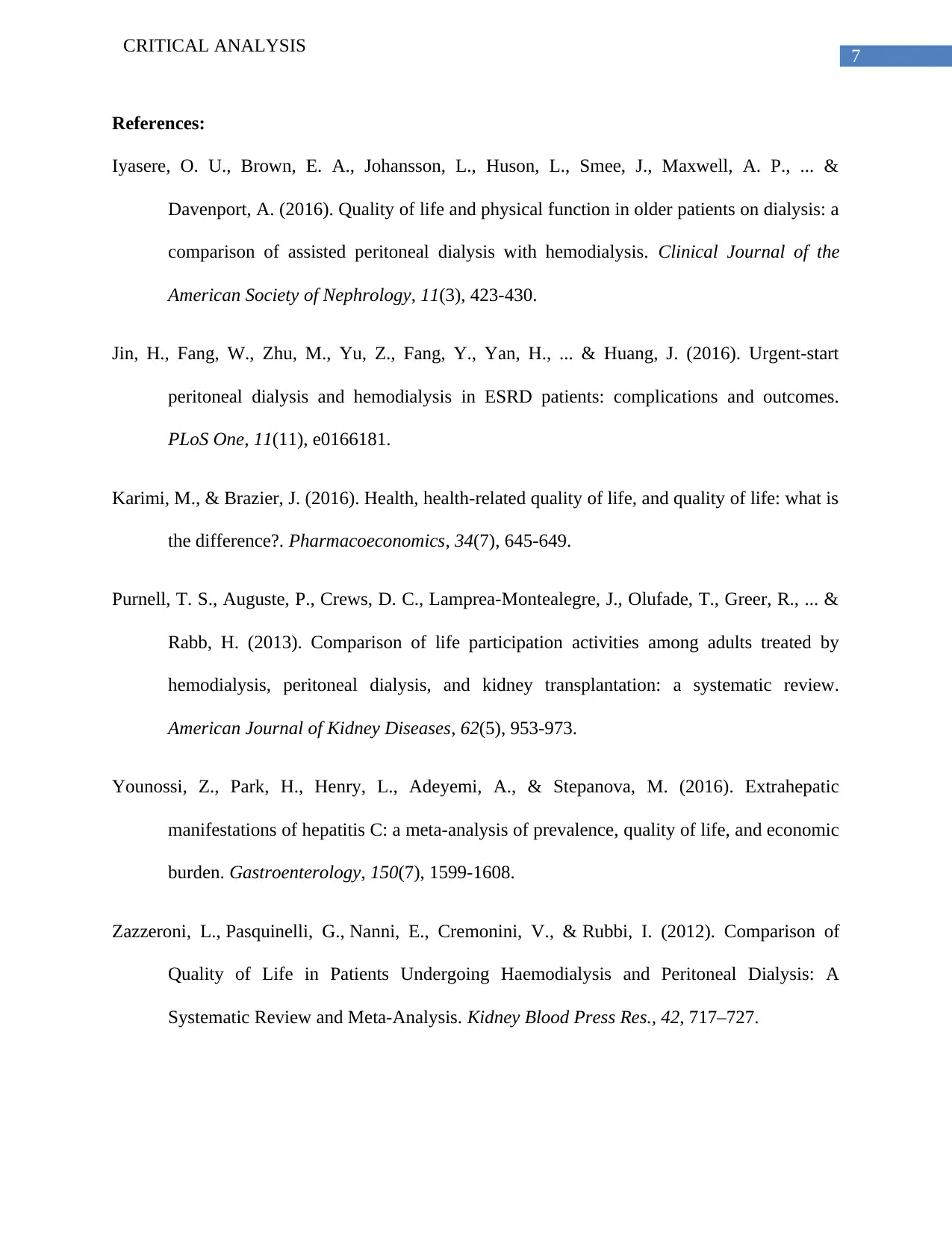
7
CRITICAL ANALYSIS
References:
Iyasere, O. U., Brown, E. A., Johansson, L., Huson, L., Smee, J., Maxwell, A. P., ... &
Davenport, A. (2016). Quality of life and physical function in older patients on dialysis: a
comparison of assisted peritoneal dialysis with hemodialysis. Clinical Journal of the
American Society of Nephrology, 11(3), 423-430.
Jin, H., Fang, W., Zhu, M., Yu, Z., Fang, Y., Yan, H., ... & Huang, J. (2016). Urgent-start
peritoneal dialysis and hemodialysis in ESRD patients: complications and outcomes.
PLoS One, 11(11), e0166181.
Karimi, M., & Brazier, J. (2016). Health, health-related quality of life, and quality of life: what is
the difference?. Pharmacoeconomics, 34(7), 645-649.
Purnell, T. S., Auguste, P., Crews, D. C., Lamprea-Montealegre, J., Olufade, T., Greer, R., ... &
Rabb, H. (2013). Comparison of life participation activities among adults treated by
hemodialysis, peritoneal dialysis, and kidney transplantation: a systematic review.
American Journal of Kidney Diseases, 62(5), 953-973.
Younossi, Z., Park, H., Henry, L., Adeyemi, A., & Stepanova, M. (2016). Extrahepatic
manifestations of hepatitis C: a meta-analysis of prevalence, quality of life, and economic
burden. Gastroenterology, 150(7), 1599-1608.
Zazzeroni, L., Pasquinelli, G., Nanni, E., Cremonini, V., & Rubbi, I. (2012). Comparison of
Quality of Life in Patients Undergoing Haemodialysis and Peritoneal Dialysis: A
Systematic Review and Meta-Analysis. Kidney Blood Press Res., 42, 717–727.
CRITICAL ANALYSIS
References:
Iyasere, O. U., Brown, E. A., Johansson, L., Huson, L., Smee, J., Maxwell, A. P., ... &
Davenport, A. (2016). Quality of life and physical function in older patients on dialysis: a
comparison of assisted peritoneal dialysis with hemodialysis. Clinical Journal of the
American Society of Nephrology, 11(3), 423-430.
Jin, H., Fang, W., Zhu, M., Yu, Z., Fang, Y., Yan, H., ... & Huang, J. (2016). Urgent-start
peritoneal dialysis and hemodialysis in ESRD patients: complications and outcomes.
PLoS One, 11(11), e0166181.
Karimi, M., & Brazier, J. (2016). Health, health-related quality of life, and quality of life: what is
the difference?. Pharmacoeconomics, 34(7), 645-649.
Purnell, T. S., Auguste, P., Crews, D. C., Lamprea-Montealegre, J., Olufade, T., Greer, R., ... &
Rabb, H. (2013). Comparison of life participation activities among adults treated by
hemodialysis, peritoneal dialysis, and kidney transplantation: a systematic review.
American Journal of Kidney Diseases, 62(5), 953-973.
Younossi, Z., Park, H., Henry, L., Adeyemi, A., & Stepanova, M. (2016). Extrahepatic
manifestations of hepatitis C: a meta-analysis of prevalence, quality of life, and economic
burden. Gastroenterology, 150(7), 1599-1608.
Zazzeroni, L., Pasquinelli, G., Nanni, E., Cremonini, V., & Rubbi, I. (2012). Comparison of
Quality of Life in Patients Undergoing Haemodialysis and Peritoneal Dialysis: A
Systematic Review and Meta-Analysis. Kidney Blood Press Res., 42, 717–727.

8
CRITICAL ANALYSIS
Zhang, X., Xuan, X., Wan, Y., Ye, L., & Gao, X. (2012). PUK6 Comparison of Quality of Life
Between Haemodialysis and Peritoneal Dialysis Patients in a Tertiary Hospital in China.
Value in Health, 15, A602–A681.
CRITICAL ANALYSIS
Zhang, X., Xuan, X., Wan, Y., Ye, L., & Gao, X. (2012). PUK6 Comparison of Quality of Life
Between Haemodialysis and Peritoneal Dialysis Patients in a Tertiary Hospital in China.
Value in Health, 15, A602–A681.
⊘ This is a preview!⊘
Do you want full access?
Subscribe today to unlock all pages.

Trusted by 1+ million students worldwide
1 out of 9
Related Documents
Your All-in-One AI-Powered Toolkit for Academic Success.
+13062052269
info@desklib.com
Available 24*7 on WhatsApp / Email
![[object Object]](/_next/static/media/star-bottom.7253800d.svg)
Unlock your academic potential
Copyright © 2020–2025 A2Z Services. All Rights Reserved. Developed and managed by ZUCOL.





